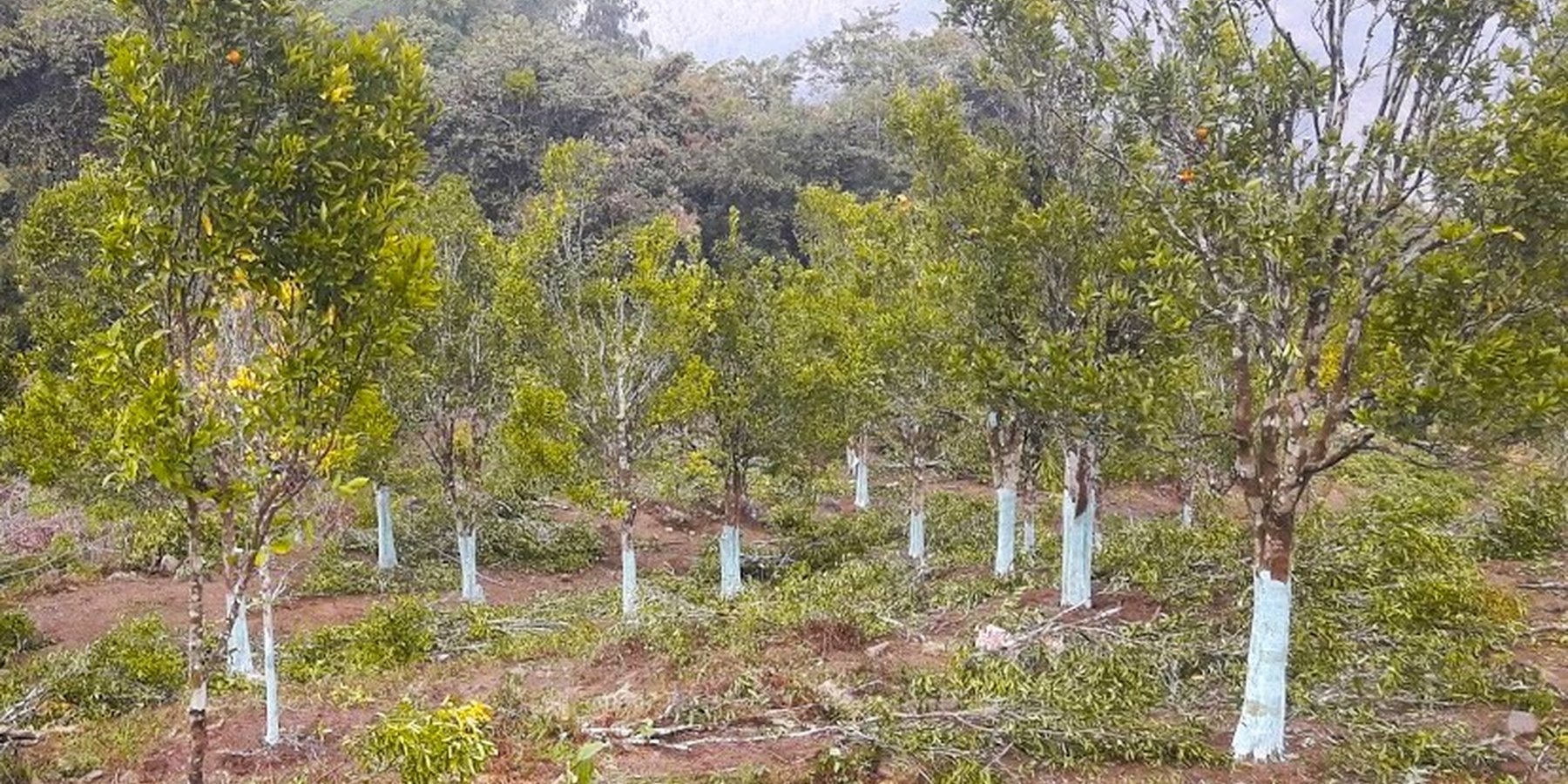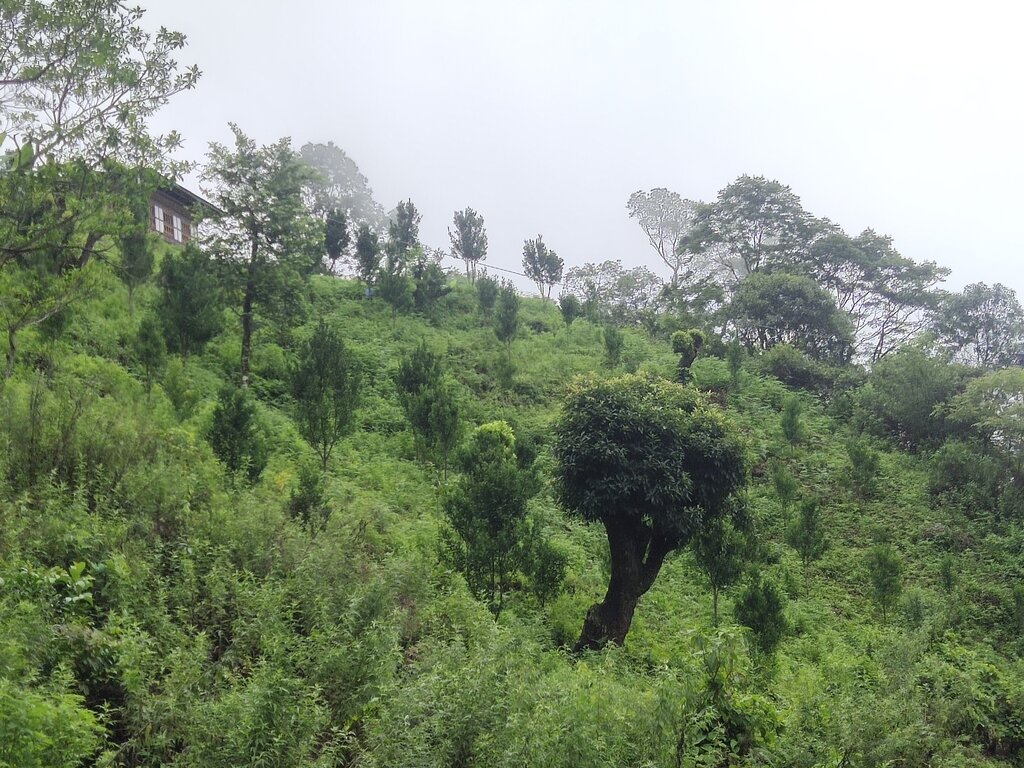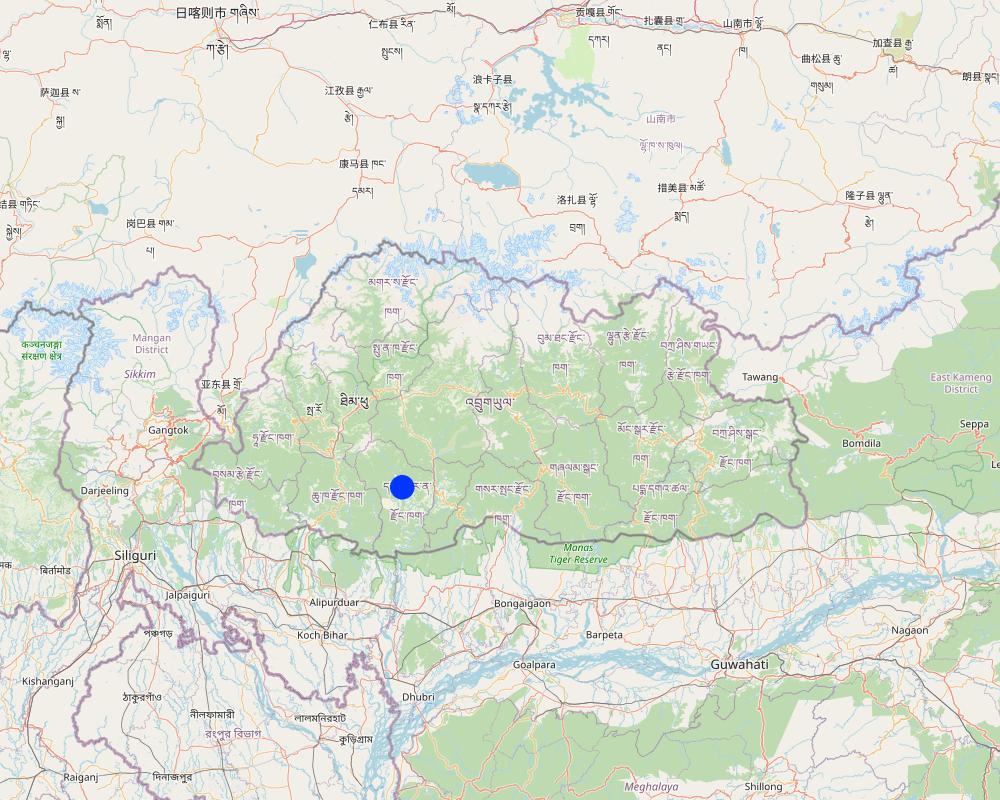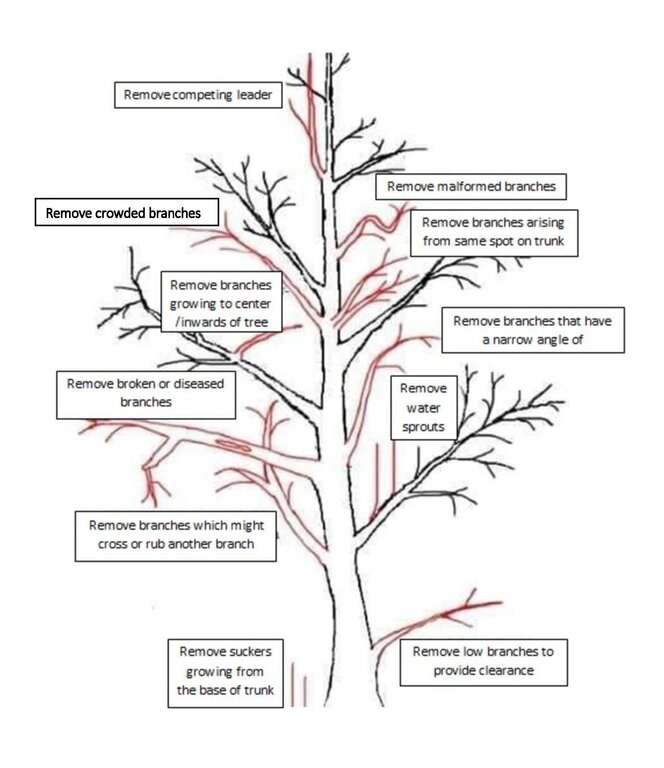Citrus Canopy Management and Rehabilitation Program [Bhutan]
- Creation:
- Update:
- Compiler: Nima Dolma Tamang
- Editor: Kuenzang Nima
- Reviewers: William Critchley, Rima Mekdaschi Studer
technologies_6847 - Bhutan
View sections
Expand all Collapse all1. General information
1.2 Contact details of resource persons and institutions involved in the assessment and documentation of the Technology
Key resource person(s)
land user:
Lethro
Bhutan
Name of project which facilitated the documentation/ evaluation of the Technology (if relevant)
Strengthening national-level institutional and professional capacities of country Parties towards enhanced UNCCD monitoring and reporting – GEF 7 EA Umbrella II (GEF 7 UNCCD Enabling Activities_Umbrella II)Name of the institution(s) which facilitated the documentation/ evaluation of the Technology (if relevant)
National Soil Services Centre, Department of Agriculture, Ministry of Agriculture & Livestock (NSSC) - Bhutan1.3 Conditions regarding the use of data documented through WOCAT
The compiler and key resource person(s) accept the conditions regarding the use of data documented through WOCAT:
Ja
1.4 Declaration on sustainability of the described Technology
Is the Technology described here problematic with regard to land degradation, so that it cannot be declared a sustainable land management technology?
Nee
2. Description of the SLM Technology
2.1 Short description of the Technology
Definition of the Technology:
Citrus canopy management refers to the set of practices and techniques employed to optimize the growth, health, and productivity of citrus trees by manipulating the structure and density of their canopy. Effective canopy management is crucial for achieving desirable outcomes in citrus cultivation, such as improved fruit quality, increased yields, efficient use of resources, and enhanced tree health.
2.2 Detailed description of the Technology
Description:
Citrus canopy management practices remain basic in Bhutan. Thus, the Australian Centre for International Agricultural Research (ACIAR) project was initiated and demonstrated citrus canopy management practices in selected orchards in 2010. In the same year, the Japan International Cooperation Agency (JICA) project trained land users and extension officers in eastern Bhutan on citrus management practices such as planting methods, nutrient management, pruning and training including top working, fruit thinning and post-harvest management practices. Since then, citrus growers have been slowly adopting the practices in their orchards. However, the adoption rate is low - affecting the yield and quality.
Bhutan has suitable climatic conditions for citrus production, particularly in the southern parts of the country due to the subtropical climate. Citrus such as oranges, mandarins and lemons are grown in orchards and home gardens. In Bhutan, citrus canopy management practices focus on optimizing tree growth, fruit production, and overall tree health. The main elements include pruning, training systems, canopy density management, tree height and size control, and disease and pest management integrated with irrigation and nutrient management practices. Pruning involves selectively removing branches, shoots, or foliage to shape the tree and improve its health. The stump should always be cut as close to the collar region as possible. Training structures the tree in a specific manner to optimize growth and management. Canopy density management regulates foliage density for light penetration and airflow. Techniques such as hedging or topping control the height and size of trees. Disease and pest management practices include adequate air circulation and sunlight exposure. Integration with irrigation and soil nutrient management enhances tree health and productivity. The desirable shape and size of citrus are variable depending on the grower's choice, location, and - most importantly - operational health and safety concerns. In general, the desirable shape and size of the tree should be 2 to 5 m tall, 2 to 5 m width of canopy, and 4 to 6 primary (scaffold) branches that are at least 1 m above the ground level.
The purposes/functions of citrus canopy management technology are to optimize fruit production, improve tree health, and facilitate harvest and maintenance operations. It helps maximize fruit yield and quality. Pruning and maintenance practices enhance tree vigour, reduce the risk of diseases and pests, and improve overall plant health. Controlling tree size and shape makes harvesting easier and more efficient, and simplifies other maintenance activities such as irrigation, fertilization, and pest control.
To establish and maintain citrus canopy management technology, activities such as regular pruning and training, knowledge and skill development, use of proper tools and equipment, monitoring and assessment, irrigation, and nutrition management are required. Regular pruning and training of citrus trees according to the selected system and management objectives is essential. Monitoring tree growth, health, and productivity is important, along with proper irrigation scheduling, water management, and nutrient application.
The benefits/impacts of the technology are improved sunlight exposure, enhanced air circulation, reduced disease incidence, increased fruit size and quality, ease of harvest, consistent yield, optimized water use, better pest management, and others. A well-managed canopy makes it easier to access the fruit during harvest, and achieve higher yields and better-quality fruits, reduced need for pesticides, as well as directing nutrients toward fruit production rather than excessive vegetative growth. However, there are some drawbacks of the technology such as the requirement for time-consuming manual labour, lower initial yields, high initial investments for equipment, and concerns about over-pruning.
2.3 Photos of the Technology
2.5 Country/ region/ locations where the Technology has been applied and which are covered by this assessment
Country:
Bhutan
Region/ State/ Province:
Dagana Dzongkhag
Further specification of location:
Nindukha Village, Kana Gewog
Specify the spread of the Technology:
- evenly spread over an area
If precise area is not known, indicate approximate area covered:
- < 0.1 km2 (10 ha)
Is/are the technology site(s) located in a permanently protected area?
Nee
Map
×2.6 Date of implementation
Indicate year of implementation:
2019
2.7 Introduction of the Technology
Specify how the Technology was introduced:
- through projects/ external interventions
3. Classification of the SLM Technology
3.1 Main purpose(s) of the Technology
- improve production
- adapt to climate change/ extremes and its impacts
- create beneficial economic impact
3.2 Current land use type(s) where the Technology is applied
Land use mixed within the same land unit:
Nee

Cropland
- Tree and shrub cropping
Tree and shrub cropping - Specify crops:
- citrus
Number of growing seasons per year:
- 1
Is intercropping practiced?
Nee
Is crop rotation practiced?
Nee
3.3 Has land use changed due to the implementation of the Technology?
Has land use changed due to the implementation of the Technology?
- No (Continue with question 3.4)
3.4 Water supply
Water supply for the land on which the Technology is applied:
- mixed rainfed-irrigated
3.5 SLM group to which the Technology belongs
- integrated soil fertility management
- irrigation management (incl. water supply, drainage)
- Tree canopy management
3.6 SLM measures comprising the Technology

vegetative measures
- V5: Others

other measures
Specify:
Improve/optimize fruit production and quality by manipulating the growth and structure of trees.
3.7 Main types of land degradation addressed by the Technology

biological degradation
- Bc: reduction of vegetation cover
Comments:
Citrus canopy management increases productivity and reduces its susceptibility to diseases which ensures vegetation cover as the trees are not removed.
3.8 Prevention, reduction, or restoration of land degradation
Specify the goal of the Technology with regard to land degradation:
- prevent land degradation
- reduce land degradation
4. Technical specifications, implementation activities, inputs, and costs
4.1 Technical drawing of the Technology
Technical specifications (related to technical drawing):
The spacing between trees is 6 m. There are a total of 100 trees per acre. Diseased or damaged trees are removed.
Author:
Thinley Penjor Dorji
Date:
22/08/2023
4.2 General information regarding the calculation of inputs and costs
Specify how costs and inputs were calculated:
- per Technology area
Indicate size and area unit:
2.47 acre
If using a local area unit, indicate conversion factor to one hectare (e.g. 1 ha = 2.47 acres): 1 ha =:
1
other/ national currency (specify):
Ngultrum (Nu.)
If relevant, indicate exchange rate from USD to local currency (e.g. 1 USD = 79.9 Brazilian Real): 1 USD =:
80.0
Indicate average wage cost of hired labour per day:
500
4.3 Establishment activities
| Activity | Timing (season) | |
|---|---|---|
| 1. | Pruning | Right after harvest |
| 2. | Applying Bordeaux mixture | Anytime |
| 3. | Making basin | Winter |
| 4. | Applying manure | Anytime |
| 5. | Removal of dead woods or shoots | Anytime |
4.4 Costs and inputs needed for establishment
| Specify input | Unit | Quantity | Costs per Unit | Total costs per input | % of costs borne by land users | |
|---|---|---|---|---|---|---|
| Labour | Pruning | Person/day | 17.0 | 500.0 | 8500.0 | 100.0 |
| Equipment | Pruning saw | Number | 1.0 | 2000.0 | 2000.0 | 100.0 |
| Equipment | Secateurs | Number | 1.0 | 2500.0 | 2500.0 | 100.0 |
| Plant material | Sapling | Number | 247.0 | 150.0 | 37050.0 | |
| Fertilizers and biocides | Bordeaux mixture | Litres | 12.0 | 125.0 | 1500.0 | |
| Total costs for establishment of the Technology | 51550.0 | |||||
| Total costs for establishment of the Technology in USD | 644.38 | |||||
If land user bore less than 100% of costs, indicate who covered the remaining costs:
The cost for sapling and biocide is borne by the Royal Government of Bhutan.
Comments:
The total establishment cost of the technology for one hectare is USD 644.38. The Land users paid 100% of the equipment's cost. They follow a labour-sharing system whereby the labour employed in the farm is compensated by working in their fields and there is no cost involved.
4.5 Maintenance/ recurrent activities
| Activity | Timing/ frequency | |
|---|---|---|
| 1. | Pruning of dead woods and water shoots | Anytime |
| 2. | Fertilizer application | Anytime |
| 3. | Shoot selection in the following years | Every year when new shoots sprout |
4.6 Costs and inputs needed for maintenance/ recurrent activities (per year)
| Specify input | Unit | Quantity | Costs per Unit | Total costs per input | % of costs borne by land users | |
|---|---|---|---|---|---|---|
| Labour | Pruning | Person/day | 7.0 | 500.0 | 3500.0 | 98.0 |
| Total costs for maintenance of the Technology | 3500.0 | |||||
| Total costs for maintenance of the Technology in USD | 43.75 | |||||
Comments:
Only labour input is needed for maintenance/recurrent activities but the cost is zero as land users follow labour-sharing system.
4.7 Most important factors affecting the costs
Describe the most determinate factors affecting the costs:
The land users mentioned that the equipment is the main factor affecting cost.
5. Natural and human environment
5.1 Climate
Annual rainfall
- < 250 mm
- 251-500 mm
- 501-750 mm
- 751-1,000 mm
- 1,001-1,500 mm
- 1,501-2,000 mm
- 2,001-3,000 mm
- 3,001-4,000 mm
- > 4,000 mm
Agro-climatic zone
- humid
The area falls under the humid Subtropical zone from the six Agro-ecological zones of Bhutan.
5.2 Topography
Slopes on average:
- flat (0-2%)
- gentle (3-5%)
- moderate (6-10%)
- rolling (11-15%)
- hilly (16-30%)
- steep (31-60%)
- very steep (>60%)
Landforms:
- plateau/plains
- ridges
- mountain slopes
- hill slopes
- footslopes
- valley floors
Altitudinal zone:
- 0-100 m a.s.l.
- 101-500 m a.s.l.
- 501-1,000 m a.s.l.
- 1,001-1,500 m a.s.l.
- 1,501-2,000 m a.s.l.
- 2,001-2,500 m a.s.l.
- 2,501-3,000 m a.s.l.
- 3,001-4,000 m a.s.l.
- > 4,000 m a.s.l.
Indicate if the Technology is specifically applied in:
- not relevant
5.3 Soils
Soil depth on average:
- very shallow (0-20 cm)
- shallow (21-50 cm)
- moderately deep (51-80 cm)
- deep (81-120 cm)
- very deep (> 120 cm)
Soil texture (topsoil):
- coarse/ light (sandy)
Soil texture (> 20 cm below surface):
- coarse/ light (sandy)
Topsoil organic matter:
- high (>3%)
If available, attach full soil description or specify the available information, e.g. soil type, soil PH/ acidity, Cation Exchange Capacity, nitrogen, salinity etc.
Moisture content 2.88%, organic matter 6.17%, Organic carbon 3.59%, pH 6.23, electrical conductivity 178.27 µs/cm, nitrogen 0.18%, phosphorus 0.57 ppm, Potassium 134.73 mg/100ml, texture sand clay loam.
The soil analysis was conducted at the Science Laboratory of College of Natural Resources, Royal University of Bhutan, Lobesa, Punakha.
5.4 Water availability and quality
Availability of surface water:
good
Water quality (untreated):
good drinking water
Water quality refers to:
surface water
Is water salinity a problem?
Nee
Is flooding of the area occurring?
Nee
5.5 Biodiversity
Species diversity:
- medium
Habitat diversity:
- medium
Comments and further specifications on biodiversity:
The species and habitat diversity provided above are for the citrus orchard.
5.6 Characteristics of land users applying the Technology
Sedentary or nomadic:
- Sedentary
Market orientation of production system:
- mixed (subsistence/ commercial)
Off-farm income:
- less than 10% of all income
Relative level of wealth:
- average
Individuals or groups:
- individual/ household
Level of mechanization:
- manual work
Gender:
- men
Age of land users:
- middle-aged
5.7 Average area of land used by land users applying the Technology
- < 0.5 ha
- 0.5-1 ha
- 1-2 ha
- 2-5 ha
- 5-15 ha
- 15-50 ha
- 50-100 ha
- 100-500 ha
- 500-1,000 ha
- 1,000-10,000 ha
- > 10,000 ha
Is this considered small-, medium- or large-scale (referring to local context)?
- small-scale
Comments:
The orchard was of 1.3 acres or 0.52 hectares. The average land holding of Bhutan is 3.4 acres. Land users owning less than 3.4 acres are categorized as small-scale.
5.8 Land ownership, land use rights, and water use rights
Land ownership:
- individual, titled
Land use rights:
- individual
Water use rights:
- communal (organized)
Are land use rights based on a traditional legal system?
Ja
Specify:
The land use rights in Bhutan is traditional legal system guided by formal land act and land rules and regulations.
5.9 Access to services and infrastructure
health:
- poor
- moderate
- good
education:
- poor
- moderate
- good
technical assistance:
- poor
- moderate
- good
employment (e.g. off-farm):
- poor
- moderate
- good
markets:
- poor
- moderate
- good
energy:
- poor
- moderate
- good
roads and transport:
- poor
- moderate
- good
drinking water and sanitation:
- poor
- moderate
- good
financial services:
- poor
- moderate
- good
6. Impacts and concluding statements
6.1 On-site impacts the Technology has shown
Socio-economic impacts
Production
crop production
Comments/ specify:
Land users mentioned that there was a significant increase in crop yield after canopy management.
crop quality
Quantity before SLM:
50-60%
Quantity after SLM:
80%
Comments/ specify:
The land users stated that the size of the fruit was bigger and of better quality after canopy management.
risk of production failure
Comments/ specify:
The land users stated that the risk of producing lower quality fruits that are not acceptable in the market has greatly reduced.
Income and costs
expenses on agricultural inputs
Comments/ specify:
The cost of equipment is moderately expensive. However, the land users feel the cost is compensated by the increase in income. The land users also take special care of the equipment.
farm income
Comments/ specify:
Improved quality and quantity of citrus are directly related to increased farm income as there is a higher price provided for good quality produce.
workload
Quantity before SLM:
40%
Quantity after SLM:
50%
Comments/ specify:
The management practices such as training, pruning, and application of Bordeaux mixture are laborious. Therefore, the workload of land users has increased by about 10 per cent.
Socio-cultural impacts
food security/ self-sufficiency
Comments/ specify:
The land users are self-sufficient in terms of citrus. Further, the portion of their yield is shared with their relatives making the community self-sufficient. The income generated from selling the produce is used to procure nutritious foods from the market making them food secure.
health situation
Comments/ specify:
Improved income if used efficiently increases the health situation of the family members.
SLM/ land degradation knowledge
Comments/ specify:
The traditional practice did not include nutrient management of the orchard. The citrus canopy management technology includes proper manuring or nutrient management of the orchard leading to increased knowledge of SLM for the land users.
Ecological impacts
Biodiversity: vegetation, animals
Vegetation cover
Comments/ specify:
The technology improved tree health reducing the risk of orchards converting to fallow land and increasing vegetation cover.
beneficial species
Comments/ specify:
The improved soil and canopy management increased earthworm and bee populations on the farm.
pest/ disease control
Comments/ specify:
After canopy management, the land users stated that they have experienced fewer pest and disease incidences. This could be due to better sunlight penetration and air movement in the tree canopy.
6.2 Off-site impacts the Technology has shown
damage on neighbours' fields
Comments/ specify:
The orchard harbouring pests and diseases can damage neighbouring fields as the diseases are transmitted from one field to another through vectors and other sources. Therefore, the technology improves the health of the orchard and prevents the risk of damaging neighbouring orchards.
6.3 Exposure and sensitivity of the Technology to gradual climate change and climate-related extremes/ disasters (as perceived by land users)
Gradual climate change
Gradual climate change
| Season | increase or decrease | How does the Technology cope with it? | |
|---|---|---|---|
| annual temperature | increase | well | |
| annual rainfall | decrease | well |
Climate-related extremes (disasters)
Meteorological disasters
| How does the Technology cope with it? | |
|---|---|
| local hailstorm | not well |
Biological disasters
| How does the Technology cope with it? | |
|---|---|
| epidemic diseases | not well |
| insect/ worm infestation | not well |
6.4 Cost-benefit analysis
How do the benefits compare with the establishment costs (from land users’ perspective)?
Short-term returns:
slightly negative
Long-term returns:
very positive
How do the benefits compare with the maintenance/ recurrent costs (from land users' perspective)?
Short-term returns:
positive
Long-term returns:
positive
6.5 Adoption of the Technology
- 11-50%
If available, quantify (no. of households and/ or area covered):
7 households adopted the technology from the total of 50 households.
Of all those who have adopted the Technology, how many did so spontaneously, i.e. without receiving any material incentives/ payments?
- 0-10%
Comments:
All the farmers received material incentives from the government.
6.6 Adaptation
Has the Technology been modified recently to adapt to changing conditions?
Nee
6.7 Strengths/ advantages/ opportunities of the Technology
| Strengths/ advantages/ opportunities in the land user’s view |
|---|
| Increased production. The canopy management technology increases production in the long run although there is a sudden reduction in the yield in the first year of implementation. |
| Improved quality. The technology is a wholesome approach to improving the canopy, nutrient management and irrigation management leading to quality fruit production. |
| Reduced pests and disease incidence. The technology reduces the favourable environment for the multiplication of diseases and pest. For example, by pruning the canopy which increases aeration ultimately reducing fungal growth. |
| Strengths/ advantages/ opportunities in the compiler’s or other key resource person’s view |
|---|
| Increased income and improved livelihood. Canopy management increases yield in the long run leading to increased farm income and improved living standards of the land users. |
6.8 Weaknesses/ disadvantages/ risks of the Technology and ways of overcoming them
| Weaknesses/ disadvantages/ risks in the land user’s view | How can they be overcome? |
|---|---|
| Labour intensive. The technology includes pruning, thinning, irrigation and nutrient management activities which require a lot of labour. | Implementing a labour-sharing mechanism as it is cost-effective and strengthens community collaboration. |
| Weaknesses/ disadvantages/ risks in the compiler’s or other key resource person’s view | How can they be overcome? |
|---|---|
| Low initial crop yield. Due to excessive pruning in the first year of technology implementation, there is a marked reduction in the yield of the citrus. | With better care and management, yields increase after 2 to 3 years. |
7. References and links
7.1 Methods/ sources of information
- field visits, field surveys
One
- interviews with land users
One
When were the data compiled (in the field)?
15/07/2023
7.3 Links to relevant online information
Title/ description:
Canopy Management Guide for Citrus Mandarin in Bhutan
URL:
http://rcbajo.gov.bt/wp-content/uploads/2020/05/Canopy-management-guide-for-citrus-mandarin.pdf
Title/ description:
Pruning and Training - Evergreen Trees
URL:
http://rcbajo.gov.bt/wp-content/uploads/2020/06/Pruning-Training-evergreen.pdf
Links and modules
Expand all Collapse allLinks
No links
Modules
No modules






